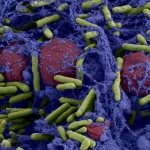Link to Pubmed [PMID] – 9628352
Biol Chem. 1998 Apr-May;379(4-5):553-7.
Epigenetic mechanisms are not exclusively reserved to eukaryotic organisms. They are also observed in prokaryotes. As described first by Hotchkiss and Gabor, protoplast fusion between strains of Bacillus subtilis produces heterodiploid cells. Heterodiploidy is associated with the inactivation of one of the chromosomes. To study the physical structure of the fusion product and the molecular mechanisms of inactivation, we constructed heterodiploid clones containing two chromosomes labeled by a NotI restriction fragment length polymorphism. In the progeny, we identified haploid recombinant clones that contain a chromosome carrying large regions of inactivated DNA. Studies of both recombinants of the latter kind and heterodiploid cells indicated that chromosomal inactivation was not determined by alteration of the inactivated nucleotide sequence, but was probably due to a modification in the structure of the bacterial chromatin.

